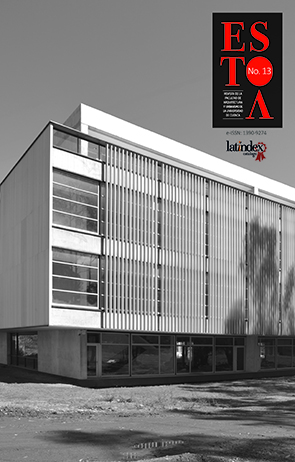Erasing architecture: the neutralization of the architectural object in the 21st century
DOI:
https://doi.org/10.18537/est.v007.n013.a05Keywords:
architectural object, site, neutralization, 21st centuryAbstract
Many of the most famous and relevant buildings of the 21st century are characterized by being singular, unusual and striking. This widespread way to approach design emphasizes the autonomy of the architectural object at the expense of its ability to build connections with the site. However, in the last years, another architectural paradigm, quite opposite to this one, has gained importance. This other paradigm goes on to neutralize the object, instead of accentuating its presence. The architecture that this paradigm proposes try to go unnoticed, to accept to appear ordinary, and sometimes goes as far as to question the need of its own construction. Nowadays the most commonly used strategies to neutralize the architectural objects are camouflage, anonymity and minimization. The purpose of this article is to explain the characteristics of this paradigm and the reasons of its relevance in contemporary architecture.
Downloads
References
Barozzi F. y Veiga A. (2015). Especificidad y Autonomía. El Croquis, 181, 95-101.
Barthes, R. (2002). Lo neutro (P. Willson trad.), México D.F., México: Siglo XXI editores.
Barthes, R. (2005). El grado cero de la escritura (N. Rosa trad.). Madrid, España: Siglo XXI editores. Originariamente publicado en 1953.
Baudrillard, J. y Nouvel, J. (2001). Los objetos singulares (H. Zabaljauregui trad.), Buenos Aires, Argentina: Fondo de cultura económica.
Baumberger, C. (2009). Ambiguity in architecture. En: G. Ernst, O. Scholz y J. Steinbrenner (Eds.), From logic to art: themes from Nelson Goodman (pp. 293-319), Fráncfort, Alemania: Ontos.
Beigel, F. (2002). Recycled landscapes, Madrid, España: Fundación COAM.
Biraghi, M. (2008). Storia dell’architettura contemporanea, Turín, Italia: Giulio Einaudi editore.
Cocteau, J. (2013). Citado en Hernández Pezzi, E. (2013). Paisaje/ Despaisaje. En: E. Hernández Pezzi, F. Jarauta, C. Jordá, y C. Pinós, Foro crítica, Otra arquitectura, otro paisaje (pp. 25-42). Alicante, España: Colegio Territorial de Arquitectos de Alicante y Universidad de Alicante.
Dorfles, G. (2008). Horror Pleni, Roma, Italia: Castelvecchi editore
Focillon, H. (1983). Vida de las formas (J. C. del Agua trad.), Madrid, España: Xarait ediciones. Originariamente publicado en 1934.
Fujimoto, S. (2013). Citado en Hernández Pezzi, E. (2013). Paisaje/ Despaisaje. En: E. Hernández Pezzi, F. Jarauta, C. Jordá, y C. Pinós, Foro crítica, Otra arquitectura, otro paisaje (pp. 25-42). Alicante, España: Colegio Territorial de Arquitectos de Alicante y Universidad de Alicante.
Hernández Pezzi, E. (2013). Paisaje/ Despaisaje. En E. Hernández Pezzi, F. Jarauta, C. Jordá y C. Pinós, Foro crítica, Otra arquitectura, otro paisaje (pp. 25-42). Alicante, España: Colegio Territorial de Arquitectos de Alicante y Universidad de Alicante.
Kuma, K. (2004). Introduction. En B. Bognar (ed.), Kengo Kuma: selected works, New York, EEEUU: Princeton Architectural Press.
Kuma K. (2008). Antiobject: the dissolution and disintegration of architecture (H. Watanabe trad.). Londres, Reino Unido: Architectural Association Publications.
Lacaton, A., y Vassal, J. P. (2002). Place Léon Aucoc, 2G. Revista Internacional de Arquitectura, 21, 30-31
Melville, H. (2007). Bartleby el escribiente (M. J. Chulia trad.), Madrid, España: Editorial Nórdica. Originariamente publicado en 1853.
Moneo, R. (2007). Otra Modernidad. En F. dal Co, J. M. Hernández León, J. J. Lahuerta, y R. Moneo, Arquitectura y ciudad, la tradición moderna entre la continuidad y la ruptura, Madrid, España: Circulo de Bellas Artes.
n’UNDO (2017). Desde la resta, Barcelona, España: dpr –barcelona.
Repishti, F. (2008). Green architecture. Oltre la metafora. Lotus International, 135, 34-4.
Stephens, S. (1999). The Bilbao Effect. What are the implications of the Bilbao's success bothfor Gehry's practice and for the architectural world at large? Architectural Record, 187 (5), 168-173.
Till, J. (2009). Architecture depends, Cambridge, EEUU: The Mit Press.
Walker, E. (2010). Lo ordinario, Barcelona, España: Editorial Gustavo Gili.
Wagner, M.C. (2017). Wang Shu Interview: Architecture is a Job for God. Louisiana Chanel. Videos on the arts, featuring the artists. Recuperado de http://channel.louisiana.dk/video/wang-shu-architecture-job-god
Published
How to Cite
Issue
Section
License
The Journal declines any responsibility for possible conflicts derived from the authorship of the works that are published in it.
The University of Cuenca in Ecuador conserves the patrimonial rights (copyright) of the published works and will favor the reuse of the same ones, these can be: copy, use, diffuse, transmit and expose publicly.
Unless otherwise indicated, all contents of the electronic edition are distributed under a Creative Commons Attribution-NonCommercial-ShareAlike 4.0 International License.




